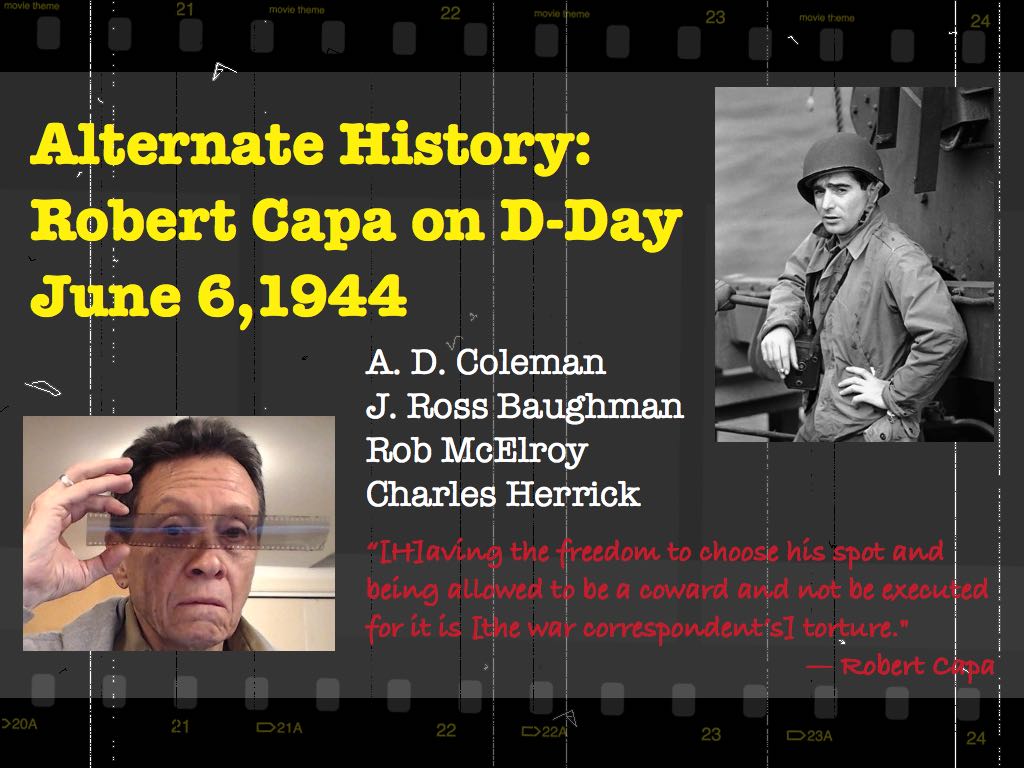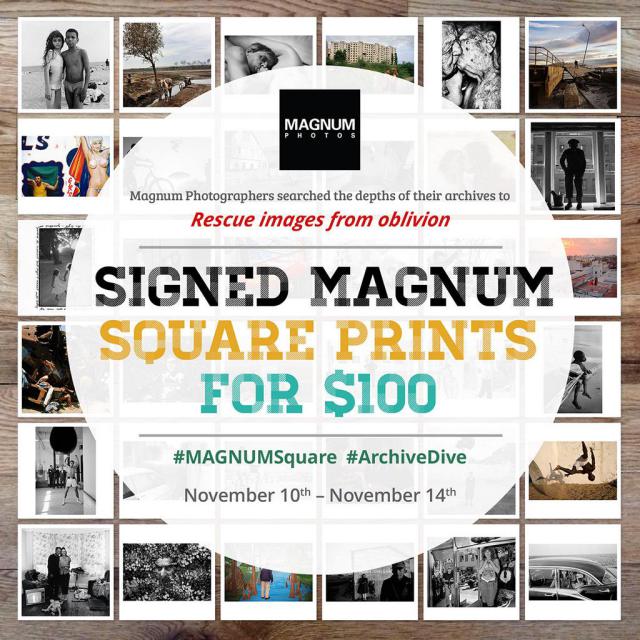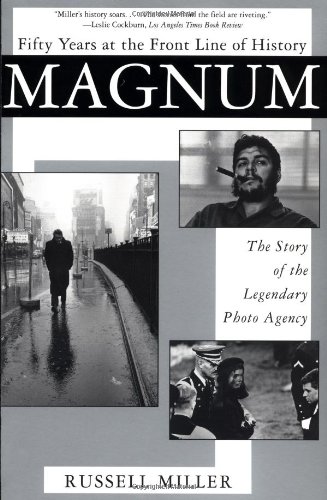In retrospect, Patrick Zachmann’s intervention on behalf of Magnum Inc. after my lecture on the evening of June 5, 2015 at the Athens Photo Festival (APhF) probably qualifies more as the weigh-in than the first round. What follows comes closer to the start of the match.
•
Returning home from Greece, I found an email from my collaborator on this project, J. Ross Baughman, pointing me toward several recent news stories about Magnum. These included “Magnum Chooses the Decisive, and Transforming, Photo,” by Rena Silverman, in the June 8, 2015 issue of the New York Times. Silverman’s rewrite of a Magnum press release details a 5-day online sale of “square prints” by Magnum photographers, who chose an image each and captioned them.
As this Times advertorial — complimentary in the several sense of the word — indicates, “All photos are offered as signed, square 6-by-6-inch prints [digitally printed on Fuji Crystal Archive Matte paper] for $100 each.” This marks the third time that Magnum has offered such prints; the second time they did so, in June 2014, the demand crashed their website. (Notably, Silverman neglected to ask what effect flooding the market with cheap, signed, uneditioned prints by these photographers would have on the market for their other prints.)
 According to Magnum executive director David Kogan, who took office in July 2015, the 2013-2014 “square print” sales grossed over $800,000. (Kogan was “dubbed a ‘TV rights wizard’ by the U.K.’s Daily Mail after advising the Premier League on its multi-billion pound rights auctions” for broadcast of soccer games.) We learn these things from another article published almost simultaneously in The Guardian (U.K.), “Magnum is too important to fail. It will be saved and it is prospering,” by Tara Conlan, datelined June 7, 2015. This lengthy article, whose author knows little or nothing about photography, masquerades as an interview/profile, but in fact functions as a promotional puff piece all about the Magnum brand and product line. Some excerpts:
According to Magnum executive director David Kogan, who took office in July 2015, the 2013-2014 “square print” sales grossed over $800,000. (Kogan was “dubbed a ‘TV rights wizard’ by the U.K.’s Daily Mail after advising the Premier League on its multi-billion pound rights auctions” for broadcast of soccer games.) We learn these things from another article published almost simultaneously in The Guardian (U.K.), “Magnum is too important to fail. It will be saved and it is prospering,” by Tara Conlan, datelined June 7, 2015. This lengthy article, whose author knows little or nothing about photography, masquerades as an interview/profile, but in fact functions as a promotional puff piece all about the Magnum brand and product line. Some excerpts:
Having borne witness to some of the biggest events in history over the last 68 years, Magnum Photos is the best-known brand in photojournalism. But it is about to be introduced to a new generation if chief executive David Kogan’s strategy to ensure the survival of the photo co-operative … pays off, literally.
With a TV drama written by Ronan Bennett and produced by Downton Abbey-makers Carnival, plus a drive for new revenue streams from branded merchandise, media partnerships and leveraging its reputation for quality photographs among the Instagram generation, Magnum is poised to become even more famous. …
Magnum’s revenue streams include selling its images to newspapers, corporate work, print sales, educational workshops and merchandise. Traditionally selling Magnum’s content has been in business to business. Kogan wants to target consumers more. …
The other part of the strategy is “the Magnum Photos brand itself” with a deal with the publisher Thames & Hudson to put the name on notebooks and potentially on “things that represent our brand values” such as luggage, clothes and watches. The television drama — which is for one series so far — should also help. … He says they are also “talking to some large media groups about large, strategic partnerships and those would include, potentially, television partnerships as well as photographic.”
 That docudrama, titled Magnum, “will tell the human stories of love, honour, laughter, betrayal and heartbreak that existed at the agency’s Paris HQ, whilst capturing the action and danger the photographers experienced traveling the world’s hotspots in the second half of the 20th Century.” (See “‘Downton Abbey’ Producer Carnival Films Developing Photo Agency Drama” by Nellie Andreeva, posted at Deadline.com on October 10, 2014.) “We are delighted to be working with Carnival to tell the story of our founding photographers and how it all began,” Kogan states in a variant of this press release at Digital Spy. (Note: On January 2 of this year I emailed Gareth Neame, Managing Director of Carnival Films, to make sure his team knew of our research. I never heard back from anyone there. I look forward to seeing what role (if any) the Capa D-Day myth plays in this account of “how it all began.”)
That docudrama, titled Magnum, “will tell the human stories of love, honour, laughter, betrayal and heartbreak that existed at the agency’s Paris HQ, whilst capturing the action and danger the photographers experienced traveling the world’s hotspots in the second half of the 20th Century.” (See “‘Downton Abbey’ Producer Carnival Films Developing Photo Agency Drama” by Nellie Andreeva, posted at Deadline.com on October 10, 2014.) “We are delighted to be working with Carnival to tell the story of our founding photographers and how it all began,” Kogan states in a variant of this press release at Digital Spy. (Note: On January 2 of this year I emailed Gareth Neame, Managing Director of Carnival Films, to make sure his team knew of our research. I never heard back from anyone there. I look forward to seeing what role (if any) the Capa D-Day myth plays in this account of “how it all began.”)
Nothing Personal, It’s Just Business
In short, Magnum in the 21st century resembles only remotely, if at all, the bohemian collective cum anarcho-syndicalist commune of its origins and first several decades, though all involved continue to cultivate that reputation. (See, for example, Russell Miller’s Magnum: Fifty Years at the Front Line of History, published in 1999, an institutional biography that details many of their notorious contentions.) Instead, inexorably if improbably, Magnum Photos has evolved into a substantial corporate entity with a multimillion-dollar annual revenue stream, a recognizable and decidedly upscale brand, an extensive and metastasizing product line, and a new executive director committed to aggressive and inventive marketing.
I feel confident they’ll soon have their own vineyards producing an array of wines, liqueurs, and (inevitably) champagne as well. Plus a line of logoized sportswear and gimme caps for the hoi polloi, and high-end leather goods for the wealthy. In his head, I have no doubt, David Kogan already envisions Kanye West onstage in the tee and Kim Kardashian accessorizing with the shoulderbag.
Like many highly profitable enterprises, Magnum Photos has spun off a non-profit arm, the Magnum Foundation, established in 2007 and committed to “support, train, and mentor the next generation of photographers and seek to increase the impact of both historical and contemporary documentary photography in the digital age.” Through this entity, supported (one assumes) at least in part by the revenues from the corporate side, Magnum stages symposia, offers workshops in multimedia, awards “emergency grants” (mostly subsidies for book and exhibition projects, from what I can glean), and does other good works under the leadership of foundation president and (for some time) Acting Executive Director Susan Meiselas.
The foundation just named its new Executive Director — Kristen Lubben, formerly a curator at the International Center of Photography. Starting in 1997, Lubben organized more than 20 exhibitions at ICP, among them the 2011 monograph and accompanying 2012 exhibition Magnum Contact Sheets. What with Mark Lubell — Kogan’s predecessor as Executive Director of Magnum Photos — now at the helm of ICP, one can take this as formal confirmation of the close if not umbilical bond between ICP and the Magnum enterprise.
[Note, December 12, 2015: In addition to this revolving-door arrangement for executives moving from one sector to another of the Capa Consortium, the Jersey Independent reports that “The top floor [of Mana Contemporary, the emerging art center] includes archives of the Magnum Foundation as well as a satellite office and archive facilities of the International Center of Photography (ICP).” Mana Contemporary is located in the Marion section of Jersey City, just across the Hudson from Manhattan. Indeed, as a recent visit confirmed, the Magnum Foundation and ICP’s archives sit facing each other on this complex’s 6th floor, a mere 15 paces apart, flocking together. — A. D. C.]

Magnum Foundation (l), ICP Archives (r), Mana Contemporary, December 12, 2015. Photos © copyright A. D. Coleman.
Don’t Fuck with My Hustle
In 2010 Mark Lubell, then director of Magnum Photos, masterminded the sale of Magnum’s press prints from the agency’s beginning through 2003 — over 185,000 images by more than 100 photographers. Bought by MSD Capital LP, the private investment firm of Michael Dell of Dell computers, the collection is housed at the Harry Ransom Center at the University of Texas, Austin. That sale brought Magnum an estimated $30 million, putting it decidedly in the black henceforth. (See Pete Brook’s February 12, 2010 report for Wired, “The Story Behind the Legendary Magnum Archive Sale.”
Thus, not to put too fine a point on it, Magnum has unabashedly become a privately owned capitalist venture, with the photographers as stakeholders. When Zachmann denounced me in Athens, therefore, he did so to protect his own investment and those of his business partners, as any elementary Marxian analysis would conclude.
Between the Zachmann moment in Athens and these carefully positioned, uncritical stories about Magnum’s new directions (including the upcoming TV series), I’ve become persuaded that the time has come to examine the role that Magnum Photos — the picture agency conceived by Robert Capa and founded by him and several colleagues in 1947 — has played in the promulgation of the myth of Capa’s actions on D-Day and the subsequent fate of his negatives, as well as this cooperative’s accountability for the part it has played in covering up the truth.

“Alternate History: Robert Capa on D-Day,” A. D. Coleman Keynote presentation, title slide, June 2015
This research project on Capa’s ten D-Day exposures and their afterlife will not likely have any discernible effect on the agency’s bottom line in the coming years; certainly it’s not intended to diminish their profits. Nor do I expect it to have any discernible effect on the doings of the foundation. The makers of that adulatory BBC series may well ignore our findings entirely, though I’d like to think they’d do so at the peril of losing credibility in photo circles — which may not matter to them at all.
Be that as it may, our project unquestionably challenges the origin myth of an organization that, if not actually “too important to fail,” as David Kogan would have it, is now owned and managed by people with egos large enough to believe in that vision, and to share the sense of self-importance and consequent entitlement that goes with it. That myth also underpins Magnum’s relatively newborn foundation. So I don’t expect them to take kindly to any debunking of one of the core legends concerning the figure from whose brow the agency sprang full-blown in 1947. As Louis Armstrong used to caution anyone who interfered with the smooth running of his day job, “Don’t fuck with my hustle.”
Hence Zachmann’s shot across the bow in the cradle of democracy. Damn the torpedoes, say I, full speed ahead! In my next post I’ll spell out the specific questions to which I think Magnum Photos and its members owe us some answers.
[Note, December 12, 2015: After this post appeared, George Slade forwarded to me a copy of “Magnum Business,” an article he published in Exposure, the journal of the Society for Photographic Education, in 2003. (Vol. 36, no. 2, pp. 45-56.) It’s an excellent overview of the agency’s relationship to various business models up till then, and a useful supplement to Russell Miller’s 1999 book, Magnum: Fifty Years at the Front Line of History.
Slade also pointed me toward Reiner Holzemer’s 1999 film, “Magnum Photos: The Changing of a Myth,” which provides a telling look at the agency as it passed its half-century mark, grappling with a much-changed media environment and market. — A. D. C.]
•
(For an index of links to all posts in this series, click here.)
•
This post supported by a donation from Martin Magid.









At his own blog, Re: PHOTO, the U.K.’s Peter Marshall tracks this investigation. His most recent comment, on the above post, appears in a December 7th post titled “Morning Moods – Internet at Risk.”